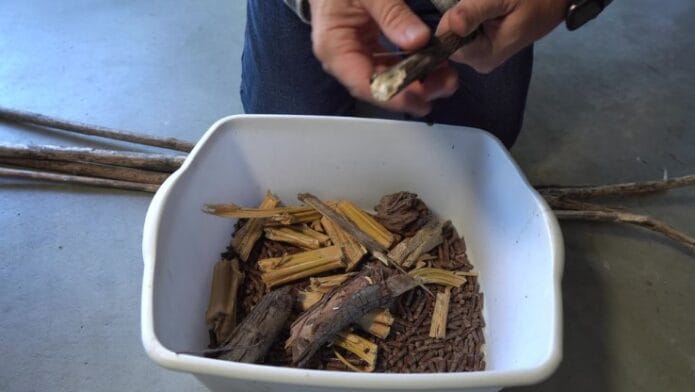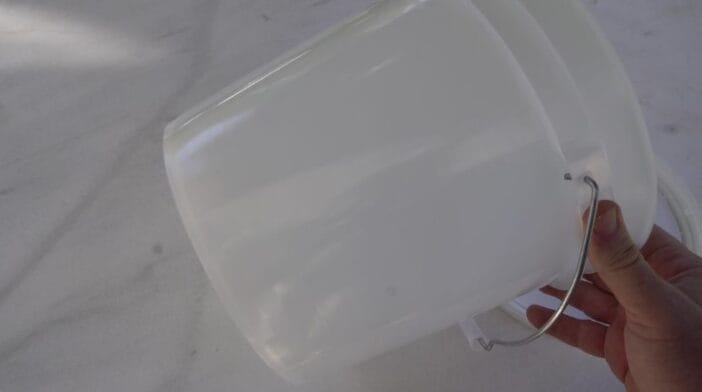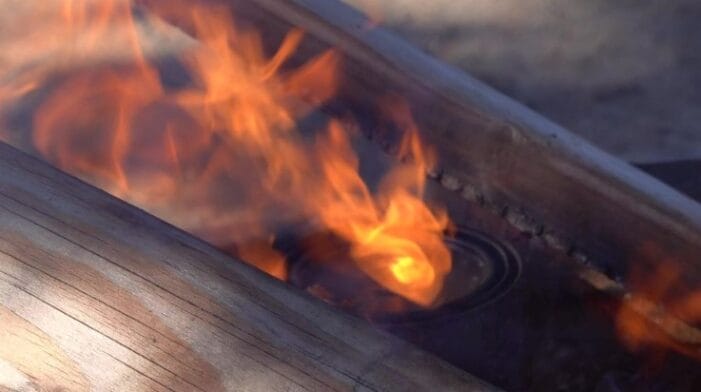After a disaster, you can’t just run to the store or order activated charcoal online, so you must know how to make its cousin charcoal. Ancient cultures made it in clay kilns or earthen firepits, but we will use materials you will most likely have access to after a disaster. After a disaster, if you need to filter water, having this homemade charcoal is vital. You won’t be able to use charcoal briquettes because of the chemicals and residues they may have in them. This homemade charcoal will give you purer carbon to work with, so it’s vital to know how to make it from scratch. I’ll explain all the many uses for charcoal towards the end of the video, and we will do a follow-up video demonstrating how to use it for water filtration. For now, let’s jump in on how to make it.
WHAT YOU’LL NEED
To make homemade charcoal, you’ll need the following:
 Carbon-Rich Material: In our case, we will use chunks of sticks and chopped wood. I’ll also use the dried amaranth and sunflower stalks from previous videos. I’ll also use these BBQ smoker hardwood pellets. You can use any wood material that you can pack in the container. These hardwood pellets will allow me to pack the containers full of wood material, and if I use the pellet charcoal later in a fire, they will burn hotter and longer than lighter wood. We will want to pack our charcoal-making container as tightly as possible.
Carbon-Rich Material: In our case, we will use chunks of sticks and chopped wood. I’ll also use the dried amaranth and sunflower stalks from previous videos. I’ll also use these BBQ smoker hardwood pellets. You can use any wood material that you can pack in the container. These hardwood pellets will allow me to pack the containers full of wood material, and if I use the pellet charcoal later in a fire, they will burn hotter and longer than lighter wood. We will want to pack our charcoal-making container as tightly as possible.
 Container: The container you use needs to be sturdy enough to withstand the fire for a few hours, depending on the volume of material you are converting. A metal drum, ammo container, unlined paint can, or Dutch oven can be used. The container’s durability will also determine how many uses you can get from it. For our example, we will use some new, all-metal paint cans, an ammo container, and a Dutch oven. Only the Dutch oven can be used repeatedly, as the other containers will deteriorate over time when exposed to the high temperatures of a fire. I am using a lined paint can to demonstrate that some of the lining will chip off and mix with your charcoal. If you plan to use charcoal for water filtration, you may be adding unknown chemicals to your water, so always try to do this with unlined paint cans.
Container: The container you use needs to be sturdy enough to withstand the fire for a few hours, depending on the volume of material you are converting. A metal drum, ammo container, unlined paint can, or Dutch oven can be used. The container’s durability will also determine how many uses you can get from it. For our example, we will use some new, all-metal paint cans, an ammo container, and a Dutch oven. Only the Dutch oven can be used repeatedly, as the other containers will deteriorate over time when exposed to the high temperatures of a fire. I am using a lined paint can to demonstrate that some of the lining will chip off and mix with your charcoal. If you plan to use charcoal for water filtration, you may be adding unknown chemicals to your water, so always try to do this with unlined paint cans.
 Fire: The typical campfire can reach temperatures in excess of 900 degrees, and that will be perfect for charcoal making.
Fire: The typical campfire can reach temperatures in excess of 900 degrees, and that will be perfect for charcoal making.
Tools: Gloves or tongs for placing the hot containers, adjusting them, or removing them from the fire.
Storage container: You will need a storage container to store the finished dry charcoal. Here, I will use a 2-gallon food storage pail.
Safety Gear: Anytime you work with an open fire, you will want safety gear. I will make sure to have a fire extinguisher handy.
THE PROCESS
- Select Raw Material: Choose a source of carbon-rich material, such as wood or other plant-based materials. The type of material you select can influence the characteristics of the final charcoal.
- Prepare the Material: Crush, break, grind, smash, or cut the selected material into small pieces or chunks. This helps increase the surface area available for the charcoal-making process.
- Make a hole in the container: You will need to make a small hole in the container’s lid to allow gasses to escape, but it is small enough to prevent oxygen from really getting in and igniting the wood. The key is to heat the material in an environment with limited oxygen to prevent combustion. With the dutchoven, the gas will vent under the heavy lid, so no modifications are required.
- Pack the Container: Pack your container with as much material as possible. Some air between the contents is okay, but it isn’t necessary. The more tightly packed you can make the container, the better. Here, I will use the stock of a large amaranth I harvested in another video, then cut it down into smaller chunks and let it dry. I will also use sunflower stalks that have dried for over a year. They will break apart easily. We’ll also pack in sticks and chunks of other pieces of wood. I will also take advantage of some cheap hardwood pellets for BBQs. Hardwood is superior in many ways. Hardwood charcoal is preferred over other types due to its higher heat output, longer burn time and lower ash production. You want to have as little air space as possible so the smaller pieces will fill in the gaps and airspaces in the container well. I was able to purchase this for around ten dollars per bag. In the wild, you can use any sticks, from twigs to dead branches you can break apart. If it’s dry enough to burn, it can be used to make charcoal. I will also fill a container with rolled-up, all cotton, t-shirt, and wood pellets to make one container that is mostly char cloth.
- Next comes the fun part–the fire. Place your containers in the fire and stack burning materials around them. What will happen is a process called “pyrolysis.” This is the same as the process we used in another video to make char cloth from a sunflower stalk. Heating the container to high temperatures causes the thermal decomposition of organic material in the absence of oxygen. The material will release smoke, gases, and moisture but not burn, leaving behind charcoal. You will first see a pretty aggressive plume of smoke. The gasses will actually ignite as they exit the hole. When this process is complete, all of that activity will subside. This is when you will want to remove your containers from the fire.
- Cool and Collect: Allow the container to cool once the pyrolysis process is complete. Let the container sit for a few hours to ensure it is cooled and extinguished completely. Fight the urge to open the container because you want the pyrolysis process to be complete. Opening the container can expose your charcoal to oxygen and may allow it to turn to embers or even catch fire. Once completely cooled, the resulting charcoal can be collected and immediately used in one of the many applications.
- Opening: Each of the containers gave me roughly the same quality and volume to the initial biomass of charcoal. I don’t know what’s in the lining. The ammo can worked well, and I could get multiple dedicated uses out of it. The paint cans were already showing signs of deterioration. As I mentioned earlier, I would have concerns about the lined paint cans because of potentially introducing trace chemical elements and toxins to my charcoal. For large quantities of charcloth, though, where the intended use is to start a fire later with it, the paint can was impressive. The Dutch Oven, in my opinion, is the simplest and most effective. It can withstand the full heat of the fire, can be used repeatedly, and is probably already in your camping equipment. If it isn’t, it should be.
- Store the homemade charcoal in a dry, durable container to prevent it from absorbing moisture and losing its effectiveness. Your charcoal can pull moisture and gasses from the air, so you must ensure the storage container is sealed well and stored in dry conditions. It doesn’t have to be completely airtight, as only the topmost layer will interact with the air.
WHAT IS HOMEMADE CHARCOAL?
WHY YOU NEED TO KNOW HOW TO MAKE IT?
Homemade charcoal serves as a practical substitute for commercial activated carbon in basic water filtration scenarios, enhancing taste and safety by reducing impurities. It can also be integrated into larger filtration systems. However, it should not be used for medical purposes, as it may contain residual substances and gases, making commercially produced activated carbon a more reliable choice for medical applications.
Homemade charcoal has versatile applications, such as serving as an effective air filter, absorbing odors, controlling humidity, and reducing volatile organic compounds (VOCs) and gases. In gardening, it raises soil pH, improves soil structure, and benefits plant growth. You can consult our other video on determining your soil pH to find out if using this homemade charcoal in this manner would benefit you. You can use this homemade charcoal as an improvised writing tool. You can also mix the powder with or soak for a long time a piece in tallow or vegetable fats. This will give it some weather-withstanding properties if you need to write directional arrows or emergency messages on boulders, sidewalks, or walls.
As a fire starter, this homemade charcoal lights easily. It will take and kindle an ignition source far better than most kindling. It burns at a higher and more consistent temperature and can burn longer than regular wood when burned in a controlled environment like a BBQ, forge, or in a low-smoke Dakota Fire Pit. This makes it suitable for forging metals. It has historical significance in blacksmithing and metalworking processes. This charcoal can be added to wood fires to enhance temperature and burn duration.
Most importantly, though, and this is how we will eventually use what we make in this video, this homemade charcoal is a perfect water filtration medium. Homemade charcoal excels at water filtration by adsorbing various impurities and chemicals. As an antioxidant, it enhances the taste and overall quality of water by removing contaminants and making it safe for consumption. By effectively binding with substances like chlorine, volatile organic compounds, pesticides, and specific heavy metals, charcoal eliminates unpleasant tastes and odors from water, making it more appealing. In this crucial role, charcoal’s ability to neutralize oxidizing agents and toxins makes it essential in the water filtration process.
After a disaster, whether you’re trying to start and keep a fire going, filter water for a community, or render the ground usable for a garden, you need this survival charcoal. With these instructions, you can have some on hand when needed. Check for our video on building an emergency water filtration system, and take a look at our video on how to build a low-smoke, low-light, traditional Dakota Fire pit. Don’t let your next bonfire or firepit fire go to waste. Use it as a prepping opportunity and make some survival charcoal.


Thank you for detailed write up, very useful, keep it up